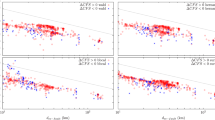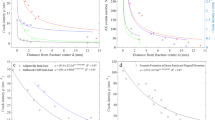Abstract
Two of the long-standing relationships of statistical seismology are power laws: the Gutenberg–Richter relation1 describing the earthquake frequency–magnitude distribution, and the Omori–Utsu law2 characterizing the temporal decay of aftershock rate following a main shock. Recently, the effect of stress on the slope (the b value) of the earthquake frequency–magnitude distribution was determined3 by investigations of the faulting-style dependence of the b value. In a similar manner, we study here aftershock sequences according to the faulting style of their main shocks. We show that the time delay before the onset of the power-law aftershock decay rate (the c value) is on average shorter for thrust main shocks than for normal fault earthquakes, taking intermediate values for strike-slip events. These similar dependences on the faulting style indicate that both of the fundamental power laws are governed by the state of stress. Focal mechanisms are known for only 2 per cent of aftershocks. Therefore, c and b values are independent estimates and can be used as new tools to infer the stress field, which remains difficult to measure directly.
This is a preview of subscription content, access via your institution
Access options
Subscribe to this journal
Receive 51 print issues and online access
$199.00 per year
only $3.90 per issue
Buy this article
- Purchase on Springer Link
- Instant access to full article PDF
Prices may be subject to local taxes which are calculated during checkout


Similar content being viewed by others
References
Gutenberg, B. & Richter, C. F. Frequency of earthquakes in California. Bull. Seismol. Soc. Am. 34, 185–188 (1944)
Utsu, T. Aftershocks and earthquake statistics. J. Fac. Sci. Hokkaido Univ. Ser. VII 3, 379–441 (1965)
Schorlemmer, D., Wiemer, S. & Wyss, M. Variations in earthquake-size distribution across different stress regimes. Nature 437, 539–542 (2005)
Narteau, C., Shebalin, P. & Holschneider, M. Temporal limits of the power law aftershock decay rate. J. Geophys. Res. 107 B2359 10.1029/2002JB001868 (2002)
Shcherbakov, R., Turcotte, D. L. & Rundle, J. B. A generalized Omori's law for earthquake aftershock decay. Geophys. Res. Lett. 31 L11613 10.1029/2004GL019808 (2004)
Vidale, J. E., Peng, Z. & Ishii, M. Anomalous aftershock decay rates in the first hundred seconds revealed from the Hi-net borehole data. Eos Trans. AGU 85 (Fall Meet. Suppl.), abstr. S23C-07 (2004)
Peng, Z. G., Vidale, J. E., Ishii, M. & Helmstetter, A. Seismicity rate immediately before and after main shock rupture from high frequency waveforms in Japan. J. Geophys. Res. 112 B03306 10.1029/2006JB004386 (2007)
Enescu, B., Mori, J. & Miyasawa, M. Quantifying early aftershock activity of the 2004 mid-Niigata Prefecture earthquake (Mw6.6). J. Geophys. Res. 112, B04310, 10.1029/2006JB004629 (2007)
Nanjo, K. Z. et al. Decay of aftershock activity for Japanese earthquakes. J. Geophys. Res. 112 B08309 10.1029/2006JB004754 (2007)
Kilb, D., Martynov, V. & Vernon, F. Aftershock detection as a function of time: results from the ANZA seismic network following the 31 October 2001 M L 5.1 Anza, California, earthquake. Bull. Seismol. Soc. Am. 97, 780–792 (2007)
Kagan, Y. Y. Short-term properties of earthquake catalogs and models of earthquake source. Bull. Seismol. Soc. Am. 94, 1207–1228 (2004)
Lolli, B. & Gasperini, P. Comparing different models of aftershock rate decay: the role of catalog incompleteness in the first times after main shock. Tectonophysics 423, 43–59 (2006)
Peng, Z. G., Vidale, J. E. & Houston, H. Anomalous early aftershock decay rate of the 2004 M w 6.0 Parkfield, California, earthquake. Geophys. Res. Lett. 33 10.1029/2006GL026744 (2006)
Hauksson, E. Crustal structure and seismicity distribution adjacent to the Pacific and North America plate boundary in southern California. J. Geophys. Res. 105, 13875–13903 (2000)
Gardner, J. & Knopoff, L. Is the sequence of earthquakes in southern California with aftershocks removed Poissonian? Bull. Seismol. Soc. Am. 5, 1363–1367 (1974)
Reasenberg, P. Second-order moment of central California seismicity, 1969–1982. J. Geophys. Res. 90, 5479–5495 (1985)
Schorlemmer, D. & Woessner, J. Probability of detecting an earthquake. Bull. Seismol. Soc. Am. 98, 2103–2117 (2008)
Wiemer, S. & Wyss, M. Minimum magnitude of completeness in earthquake catalogs: examples from Alaska, the western United States, and Japan. Bull. Seismol. Soc. Am. 90, 859–869 (2000)
Sibson, R. H. Frictional constraints on thrusts, wrench and normal faults. Nature 249, 542–544 (1974)
Dieterich, J. A constitutive law for rate of earthquake production and its application to earthquake clustering. J. Geophys. Res. 99, 2601–2618 (1994)
Scholz, C. Microfractures, aftershocks, and seismicity. Bull. Seismol. Soc. Am. 58, 1117–1130 (1968)
Shcherbakov, R. & Turcotte, D. L. A damage mechanics model for aftershocks. Pure Appl. Geophys. 161, 2379–2391 (2004)
Ben-Zion, Y. & Lyakhovsky, V. Analysis of aftershocks in a lithospheric model with seismogenic zone governed by damage rheology. Geophys. J. Int. 165, 197–210 (2006)
Atkinson, B. K. Subcritical crack growth in geological materials. J. Geophys. Res. 89, 4077–4114 (1984)
Amitrano, D. Brittle-ductile transition and associated seismicity: experimental and numerical studies and relationship with the b-value. J. Geophys. Res. B 108 2044 10.1029/2001JB000680 (2003)
O'Connell, D. R. H., Ma, S. & Archuleta, R. J. Influence of dip and velocity heterogeneity on reverse- and normal-faulting rupture dynamics and near-fault ground motions. Bull. Seismol. Soc. Am. 97, 1970–1989 (2007)
Narteau, C., Shebalin, P. & Holschneider, M. Loading rates in California inferred from aftershocks. Nonlin. Process. Geophys. 15, 245–263 (2008)
Schorlemmer, D. & Wiemer, S. Microseismicity data forecast rupture area. Nature 434, 1086 (2005)
Wells, D. L. & Coppersmith, K. J. New empirical relationships among magnitude, rupture length, rupture width, rupture area and surface displacement. Bull. Seismol. Soc. Am. 84, 974–1002 (1994)
Author information
Authors and Affiliations
Corresponding author
Supplementary information
Supplementary Information
This file contains Supplementary Notes and Data, Supplementary Figures 1- 17 with Legends, Supplementary Table 1 and Supplementary References. (PDF 5106 kb)
PowerPoint slides
Rights and permissions
About this article
Cite this article
Narteau, C., Byrdina, S., Shebalin, P. et al. Common dependence on stress for the two fundamental laws of statistical seismology . Nature 462, 642–645 (2009). https://doi.org/10.1038/nature08553
Received:
Accepted:
Issue Date:
DOI: https://doi.org/10.1038/nature08553
This article is cited by
-
Constructing the regional stress profile based on multisource regional stress data and the significance of fault friction strength
Bulletin of Engineering Geology and the Environment (2023)
-
Transient evolution of the relative size distribution of earthquakes as a risk indicator for induced seismicity
Communications Earth & Environment (2022)
-
Modeling and Prediction of Aftershock Activity
Surveys in Geophysics (2022)
-
Changes in the b value in and around the focal areas of the M6.9 and M6.8 earthquakes off the coast of Miyagi prefecture, Japan, in 2021
Earth, Planets and Space (2021)
-
The 24 January 2020 (Mw 6.8) Sivrice (Elazig, Turkey) earthquake: a first look at spatiotemporal distribution and triggering of aftershocks
Arabian Journal of Geosciences (2021)
Comments
By submitting a comment you agree to abide by our Terms and Community Guidelines. If you find something abusive or that does not comply with our terms or guidelines please flag it as inappropriate.



